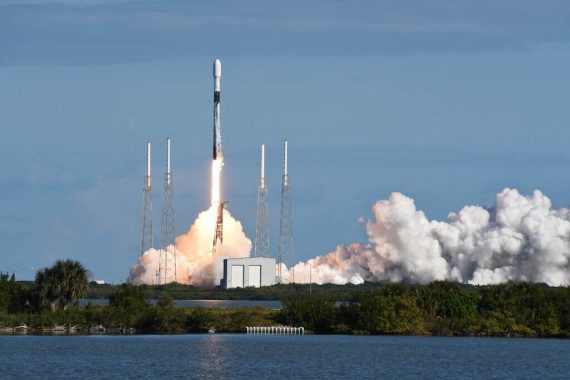T
he United States’ unilateral moment is long gone, and the previously indisputable superpower is being confronted with new rising powers that are challenging its supremacy. For several years now, a new silent but intense rivalry has been dominating the international system: the rivalry between the U.S. and China. As the need for influence, rather than land, drives this competition, these two great powers have been vying in different areas, including technology, economy, and military.
However, both the U.S. and China are also pursuing ambitious but less visible policies in another domain: space. Space competition is considered to have a crucial impact on the U.S.-China rivalry as space has become a vital geopolitical determinant in international politics.
Controlling space could have a direct impact on national securities since space can provide important advantages in terms of economy, politics, and military. Indeed, this was the main driver of the first space race during the Cold War, between the U.S. and the Soviet Union. With the collapse of the latter, the race was put on hold and the competition regained impetus several years later. However, what sets apart and makes the ongoing space race more complicated when compared to the previous one is the expanding number of actors, including both state and non-state ones.
New space actors
Formerly, the U.S. and Russia were the only two actors in the space race; now, new actors such as China, Japan, India, France, Germany, and Turkey, have joined and have increased their space activities. In the last years, space spending has increased by approximately 70% compared to 2010 and is expected to reach $1 trillion in annual revenue by 2040. It goes without saying that the U.S. and China are the two leading states.
What’s more, non-state actors—especially private companies such as SpaceX or Blue Origin—have started to dominate space affairs and, to a certain extent, are challenging the national and international space agencies. To put it into perspective, the global space economy in 2020 was estimated at $447 billion, 80% of which was covered by commercial activities of private companies.
The reasons behind these developments can be seen in the cycle wherein new developing technologies, which are easier and cheaper to develop and proliferate, have boosted the activities of private companies. At the same time, the latter have started to lower the launching costs and reduce the impediments related to space, changing the prevailing cost-benefit equation in space. To close the circle, an increase in space activities leads to the evolution of new technologies, and small satellites are an outcome of this cycle.
Small satellites
Believed to have created a revolution in the space industry—or as it sometimes called “Space 2.0”—small satellites are more compact, cheaper, and easier to develop. The constellations of a few, large, complex, and expensive satellites will be at some point replaced by mega-constellations of large numbers of small satellites which may be used both for commercial and military activities.
To give an example, SpaceX is planning to create a 42,000-strong Starlink satellite constellation in the next decades. While the benefits and risks of such a development are still being discussed, small satellites are an indispensable part of the space race between the U.S. and China, especially when we take into consideration their military application.
The small satellites which are used for commercial purposes are mainly used for communication and earth observation; however, when used for military purposes, they cover a much wider range of activities which are expected to have a direct impact on all levels of military operations. Specifically, these activities include simple tasks such as improvement of communication and navigation, as well as tasks that can have a direct impact on the battlefield including reconnaissance, intelligence gathering, targeting, and ballistic/hypersonic missile early warning.
It is important to mention that small satellites are located in low Earth orbit (LEO) or medium Earth orbit (MEO), while the previous satellites are mainly located in geostationary orbit (GEO). This not only makes the launching of these satellites cheaper and easier but at the same time the images/data received are more detailed and the communication is faster—both crucial advantages in military operations.
That said, it should be noted that while the usage of large satellites impacts only the strategic level of warfare, the usage of small satellites will have a direct impact on the tactical and operational levels as well. To put it differently, previously, the information gathered by large satellites was available mainly to decision-makers who would guide the other levels of warfare.
Space systems and military capabilities
As the space systems and technologies develop and small satellites become an indispensable asset of military activities, decision-making at the strategical level gains a timing advantage and the effectiveness of the armed forces on the ground increases considerably.
The main reason is that small satellites provide quicker and easier information, and better communication for the forces on the ground. Furthermore, if combined, small satellites can increase the effectiveness of weapon systems, such as drones. Several Chinese researchers, who emphasize the threat of the Starlink program to Chinese national security, have estimated that if combined with a Starlink connection, the data transmission speed of the U.S. military drones and stealth fighter jets could increase more than 100 times.
If we were to give a more specific example, we need look no further than the impact of Starlink satellites on the war in Ukraine. As drones are connected to the Starlink internet system, they can easily operate and hit targets in areas where there is no internet or power which is considered to have had a great impact on the Ukrainian resistance and the battleground as a whole.
For exactly this reason, many states are interested in the production and usage of small satellites, especially in the military. The rivalry between the U.S. and China has not only extended to the space domain, but both states are trying to explore new ways of using small satellites against any possible threats to their national security.
In the case of the U.S., the interest in small satellites and their application for military purposes has heightened considerably in recent years. To mention a few examples, starting in 2007, the U.S. Army Space and Missile Defense Command Technical Center’s Kestrel Eye program aimed to provide rapid images from the satellite to the tactical users (soldiers) on the ground. Two small satellites were launched under this project (2017-2018) and the results have been quite optimistic.
Project Convergence is another undertaking of the U.S. Army, where the satellites are not only used to take rapid and detailed images, but are supported by an artificial intelligence (AI) system for communication in the battlefield. Specifically, one small satellite sends a detailed image to the ground station which is enhanced with an AI system.
The AI system processes the data in the images, detects the threat, and transforms it to target data. Through satellite communication, the data is sent to another AI system which recommends a possible solution and afterwards, if approved, that solution is transferred to the soldier or the weapon system that will hit the target.
Recommended
The United States and small satellites
BlackJack program is another important project undertaken by the U.S. Defense Advanced Research Projects Agency (DARPA) whose main aim is to produce small satellites that would be used on the battleground, not only for communication and targeting but also for missile warning.
Producing small satellites is an important issue within the U.S. defense circles, considering it is claimed that China has conducted hypersonic missile tests amid the rising tensions between the two states. Within this framework, at the beginning of 2022, the U.S. Space Development Agency launched a contest for the development of a small satellites constellation that would be able to track both ballistic and hypersonic missiles.
China and small satellites
Besides the U.S., China has taken very important steps as well and shown that it poses a threat to the American space hegemony. While there is no detailed information on government programs regarding the development of small satellites for military use, the most recent developments reflect the capacity of China’s space activities.
First, in December 2021, China’s small nimble satellite Beijing-3, which has AI-enhanced reconnaissance capabilities, could take photos of American cities from space in just 42 seconds. Not only this, it could recognize military vehicles and weapons. This makes Beijing-3 one of the most powerful observation satellites considering that it is 2-3 times faster than the U.S.-made World View-4 satellite, which retired in 2019 due to technical issues.
In April 2022, news made the headlines that China had transformed a commercial small satellite into a spy satellite. Accordingly, Chinese researchers had developed an AI system that enhanced the capabilities of Jilin-1 commercial satellite. The developed system could detect small objects seen in the videos captured by Jilin-1 with a 95% precision.
Furthermore, the AI system incorporated in the satellite is able to track moving objects and can predict the possible location of a target upon losing visual contact with it (for example, a car’s trajectory after it enters a tunnel). Currently, 40 small satellites have joined Jilin-1, and it is expected they will reach 138 satellites in the future.
Again in April 2022, Chinese researchers stated that they have developed an AI system that has learned how to use deception to hunt other satellites in a simulated space battle. Specifically, the AI system instructed three hunting small satellites on how to attack/capture a targeted spacecraft. This development is of high importance when we consider the fact that the increased number of small satellites in orbit will bring with it more clashes between space powers.
China sees the Starlink satellites as a threat to its national security and has placed great importance on developing its anti-satellite (ASAT) capabilities. In this context, the above-mentioned AI system would allow China to protect its own spacecraft and to attack spacecraft that threaten its national interests.
Small satellites are a game changer not only for the space race but also for military operations. States that enhance their ground operations with data from these satellites will gain an enormous military edge. The more the geopolitical rivalry between the U.S. and China intensifies, the more these two states will try to dominate space and shift it in their favor. Both China and the U.S. are fully aware that small satellites will be the means to achieve their goals.





